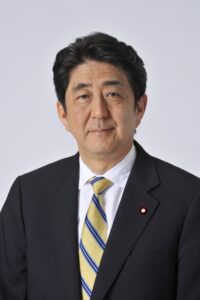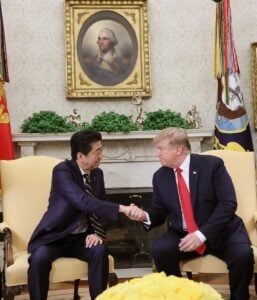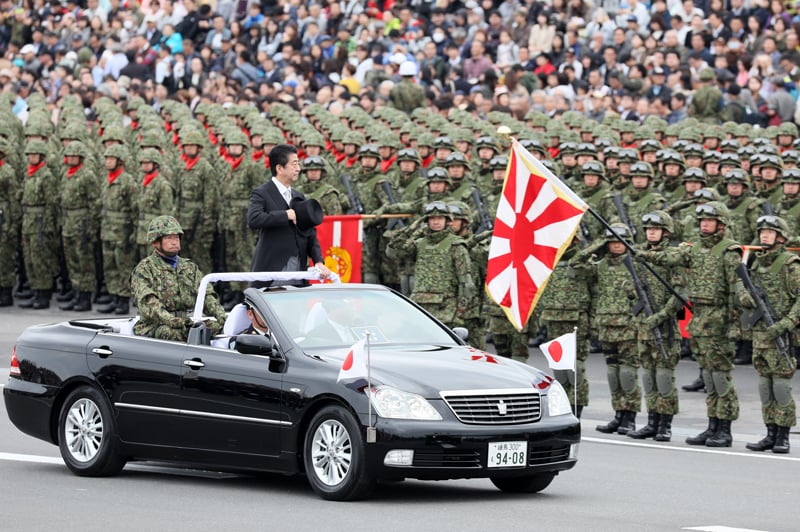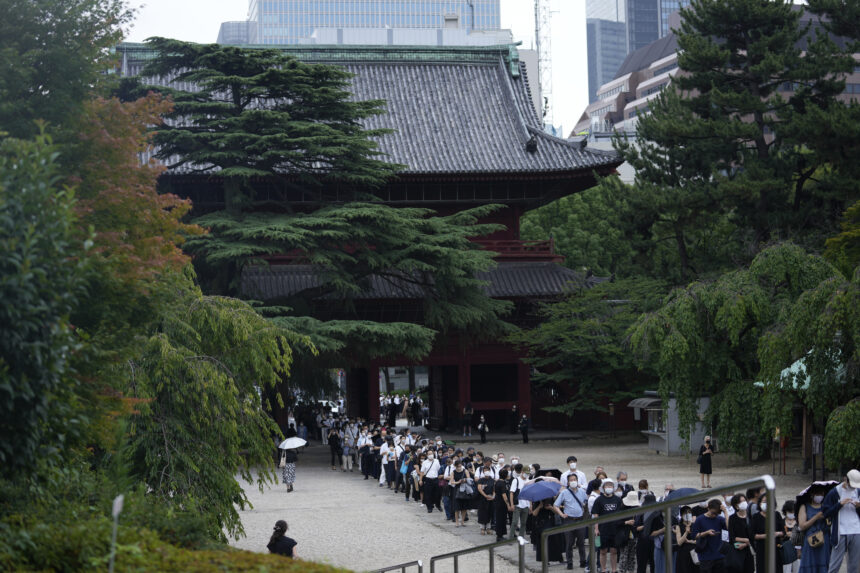Restorer of Japan
As throngs of people from all over Japanpay their respects to assassinated former Prime Minister Shinzo Abe, the world waits to see how Japan’s political future will change following his death. Abe’s assassination was a shocking disruption to a peaceful nation that has only seen three political killings since the end of World War II. The loss of Abe, a revered leader of the Japanese political right, was a blow to those who admired his leadership, but ironically his untimely death may have garnered the needed public sympathy to advance the policy goals that he was not fully able to achieve in life.
Abe was the longest-serving prime minister in the history of Japan, having been in office from 2006 to 2007 and again from 2012 to 2020, for a total of nearly nine years. In that period, especially during his second stint, Abe solidified his power over the ruling Liberal Democratic Party (LDP), imposing his nationalistic views onto a stagnant LDP that, while dominant in Japanese politics, was in desperate need of strong leadership.
Abe was born to a blue-blooded family of politicians. His grandfather, Kan Abe, came from a prominent family of landowners and became an influential member of the House of Representatives. He was a stalwart pacifist who opposed the Tojo government and Japan’s war in East Asia. Shinzo’s father, Shintaro Abe, served as minister of foreign affairs in the 1980s under Prime Minister Yasuhiro Nakasone, a close confidant of U.S. President Ronald Reagan.
In contrast to his paternal grandfather, Shinzo’s maternal grandfather, Nobusuke Kishi, was a staunch nationalist who served in the wartime cabinet of Prime Minister Hideki Tojo and then was Prime Minister from 1957 to 1960. Shinzo’s great uncle, Eisaku Satō, also served as prime minister, from 1964 to 1972.
Kishi, like many who had served in the Imperial Japanese government, felt that the post-war constitution forced onto Japan at the behest of the U.S. occupation authority was unfair and that it weakened national identity. Among other provisions, this new constitution mandated that Japan renounce any standing military, rid the emperor of his divine status, and give women the right to vote. The
Japanese were not given a say in this constitution, which was drafted largely by a team of U.S. Army judge advocate generals under the direction of General Douglas MacArthur.
It was the nationalist political philosophy of Kishi that ultimately influenced Abe’s ideology and his desire to reform the Japanese Constitution, to scrap the pacifist Article 9 and enable Japan to have a standing military. Abe said of Kishi, “Some people used to point to my grandfather as a ‘Class-A war criminal suspect,’ and I felt strong repulsion. Because of that experience, I may have become emotionally attached to ‘conservatism.’” As he was surrounded by prominent conservative politicians his whole life, Abe took naturally to continuing the legacy of his grandfather.

Shinzo Abe (Office of the Prime
Minister of Japan file photo)
Abe did not shy away from controversy as he blazed his own trail to political stardom, and pushed his conservative views to the forefront. As a member of parliament throughout most of the 1990s and early 2000s, Abe fought numerous culture war battles—for example, against what he called the “excessive sexual and gender-free education” that was promoted by left-wing parties. He also became known for his membership in and advocacy of the Nippon Kaigi (“Japan Conference”), a powerful nationalist political organization that sought to restore Japan’s Shinto religious identity and to rid the country of its postwar pacifism, secularism, and dependence on the U.S. security umbrella.
Throughout the 1990s and early 2000s, Abe built a reputation as a rising star within the LDP, holding numerous cabinet positions and eventually securing the role of chief cabinet secretary for the popular LDP politician Junichiro Koizumi, whom he would eventually succeed as prime minister.
Abe’s first stint as prime minister, from 2006 to 2007, was marred by scandal among his cabinet members and only lasted one year. Even in his first term, however, one could get a first glimpse of Abe’s nationalist agenda and dedication to fighting against globalism. Immediately upon taking office, the new prime minister focused on building strong relations with U.S. President George W. Bush and supporting the War on Terror. He started his push for constitutional reform but was unable to make much progress on this front due to the brevity of his time in office. Abe resigned from that first term, citing his battle with ulcerative colitis, which was no doubt triggered by the stress of his role.
Abe’s two LDP successors each failed after one-year premierships, and then the center-left opposition Democratic Party of Japan (DPJ) came to power in 2009, under a new prime minister for each of its three years in power. The DPJ, so accustomed to being in the opposition, struggled to implement many of its proposed policies and legislative productivity, fell to levels unprecedented in modern Japanese history. It was clear that, when actually given the reins of power, the DPJ had no clue what to do. This, coupled with the 2011 Tōhoku earthquake and the subsequent Fukushima Daiichi nuclear disaster, led to the party’s downfall in the 2012 House of Representatives election.
During the five years between his two premierships, Abe quietly built strong relations with Taiwan, whose former President Ma Ying-jeou called Abe “the Republic of China’s best friend.” When he returned to office, Abe was the first former prime minister of Japan to make a successful comeback since Shigeru Yoshida in 1948. The LDP elected Abe as its party president in the 2012 leadership election, and he went on to lead his party to a resounding victory three months later. The LDP handily flipped 175 seats and brought the opposition DPJ to the nadir of its influence, where it would stay until its complete dissolution in 2016.
Upon taking up the mantle of prime minister in 2012, Abe broke the Japanese trend of annual revolving premiers, refusing to resign or apologize amid cabinet scandals or dips in approval. He solidified his power over the next eight years, making him the longest-serving prime minister in Japanese history. During that time, Abe made sweeping changes to the country and pursued bold policy objectives in economics and overseas development projects. Culture war issues continued. Abe pushed back against requests for reparations for the Japanese Imperial Army’s actions during World War II. He refused to resettle Middle Eastern and African refugees. And he continued to promote Japan’s traditional cultural heritage.
Abe’s robust economic policy, dubbed “Abenomics,” met with mixed results but saw Japan’s nominal gross domestic product grow higher. The ratio of government debt relative to national income stabilized for the first time in decades.
Domestically, Abe proposed a bill encouraging nationalism and a “love for one’s country and hometown” among Japanese youth, and he supported changing liberal Western-style apologetic history textbooks used in schools.
Abe’s desire to maintain traditionalist views on Japanese society also carried over to what is considered to be the most sacred of all issues to practitioners of the Shinto religion: succession to the male-only Chrysanthemum Throne, the seat of the Emperor of Japan. Abe was a vocal opponent of progressive efforts to allow women to ascend to the throne during a crisis in which both of the emperor’s sons had only daughters. After the Emperor’s only grandson, Prince Hisahito, was born in 2006, Abe immediately canceled a proposed legislative amendment that would have allowed female primogeniture.

and U.S. President Donald Trump
shake hands in the White House
in April 2019 (Government of Japan
file photo)
Japan has had a consistently homogeneous society with restrictive policies on immigration and refugee resettlement. As a result, 98 percent of the population is ethnically Japanese. In refusing to resettle Middle Eastern and African refugees, Abe argued that Japan must solve its own problems before accepting any immigrants. In 2017, at the height of the conflict in Syria and while the war in Afghanistan continued to rage, Japan settled a grand total of 20 out of 19,628 refugee applicants. Instead of passively accepting the consequences of mass immigration as did many countries in the West, Abe favored a set number of short-term visas enabling migrants to “work and raise incomes for a limited period of time, and then return home.”
One issue that has plagued Japan in the past is that of the wartime “comfort women,” or sex slaves, that Imperial troops exploited during the wartime occupation of Asian nations in the 1930s and ’40s. The governments of only three countries still hound Japan over this 77-year-old issue: China, North Korea, and South Korea, with the latter often being the most vocal about reparations and apologies from the Japanese government. The issue created constant tension in the region and the U.S. often performed a diplomatic balancing act between the two countries in an effort to maintain stability and to prevent China from driving a wedge between them.
Abe took a strong stance against the constant browbeating by China and Korea over this issue. He said that because Japan had already made numerous public apologies and monetary compensations over the decades, it would not apologize again. In 2015, Japan had agreed to pay 1 billion yen (US$8.3 million) to the 46 former comfort women who were still alive at the time. Following the payment, Abe said, “We should not drag this problem into the next generation.” He and South Korean President Park Geun-hye agreed that the 2015 payment and apology would make the matter of comfort women “finally and irreversibly resolved.”
Above all this, though, was Abe’s lifelong goal to reform, if not completely repeal, Article 9 of the 1947 Constitution, which forbids Japan from ever having a standing military. Despite the Article 9 prohibition, Japan has maintained the Japan Self-Defense Forces (JSDF) since 1954. In an apparent reversal of its initial policy to completely disarm Japan, the U.S. occupation authorities encouraged Japan, during the onset of the Cold War, to form the JSDF as a de facto post-war military without calling it a military. At present, the JSDF has just under 250,000 active-duty personnel and 56,000 reservists who are divided among ground, maritime, and air forces. Article 9 still has some restrictive power, however. It restrains the JSDF’s ability to partake in overseas military operations and allows it to mobilize for combat only if Japan is directly attacked. Also, spending on the JSDF is not permitted to exceed 1 percent of Japan’s national GDP.

(Government of Japan file photo)
Despite these restrictions, left-leaning pacifist parties and politicians have argued that the JSDF is in violation of Article 9 of the Japanese Constitution. The Japanese Communist Party goes so far as to say that the JSDF should be entirely scrapped and that U.S. forces should completely vacate Japan, which would leave the nation utterly defenseless. Abe and the LDP have rejected such proposals, arguing that Japan, while wishing to maintain its strong military alliance with the U.S., does not want to remain entirely reliant on America for defense. Abe cited threats from North Korea, an expansionist China, and the beheading of two Japanese hostages by ISIS in 2015 as reasons to pursue his goal of allowing Japan’s military to intervene overseas when needed to protect Japanese citizens.
Abe and his ideological colleagues of the Nippon Kaigi school of modern Japanese nationalism have also sought to strengthen the U.S.-Japan security alliance and build military and trade relations with other regional partners. Unlike the Chinese and Korean propaganda claims that Abe’s Nippon Kaigi ideology seeks to revive Imperial Japan’s Greater East Asia Co-Prosperity Sphere, Abe’s real reasons for national self-interest can be traced to the growing military and economic expansionism of China, which Abe saw as a threat to Japanese sovereignty. The threat from China led Abe to seek closer ties with other regional countries also under threat from China, such as India, Taiwan, Vietnam, the Philippines, and Australia.
China was a new threat to a free Indo-Pacific in Abe’s view, and he thought that Japan should partake in the multilateral defense of the region to ensure not only Japan’s own sovereignty but also that of other area nations, with whom Japan had spent so many decades repairing relations after World War II.
In 2015, Abe was successful in passing new security legislation that allowed Japan to participate in “collective self-defense.” This meant that for the first time, the JSDF could come to the aid of, and defend, an ally under attack. Pacifist activists protested outside the parliament building and the Kantei, the prime minister’s residence, for weeks, but Abe stood his ground and refused to cave to their demands. He argued that the move would not lead to Japan’s becoming involved in “foreign wars,” such as the Gulf War or the Iraq War, but would instead secure peace through deterrence. Abe’s move was met with disdain by China, North Korea, and South Korea; but it was applauded by the U.S.
Although Abe was successful in normalizing Japan’s global military standing, he would not be satisfied until Article 9 was changed, so he continued to push for constitutional revision. Despite maintaining a solid supermajority in the lower house and a majority in the upper house of the Diet, Abe needed a supermajority in both houses to enact a vote on Article 9. This he would never achieve under his premiership, despite his best efforts.

For a party rife with factionalism and high turnover among prime ministers, Abe single-handedly unified the LDP under his steerage for the eight years of his second stint in office, pushing his reforms through and ousting from positions of power the moderates and liberals in his party. Despite resigning in 2020 due to a resurgence of his ulcerative colitis, Abe still maintained a tight grip on LDP policy, with most members of the party paying fealty to his leadership, ideology, and influence.
Abe was a reformer, a nationalist, and a revisionist who tried to bring a spark of patriotic life back to a Japan that had been lulled to comfort and complacency by decades under the U.S. security umbrella and the influence of Western secularism. The nation had nearly completely lost its way, its identity, and its culture. It had replaced its Shinto piety and loyalty to the emperor with an allegiance to major corporations and a workaholic lifestyle devoid of meaning.
Ironically, the death of Abe led to even more voters supporting the LDP—out of sympathy, perhaps, since electorate polling after his death showed that many said they voted for the ruling party because of Abe’s assassination. This boost gave the LDP just enough seats to achieve the required supermajority necessary to make the constitutional revisions that Abe had sought his entire political career.
In death, even Abe’s greatest critics are praising him as one of Japan’s finest statesmen. His party has coalesced around his vision, and Prime Minister Kishida is now making constitutional revision his top priority.
In the old days of the samurai, the most honorable way to die was in battle, becoming a legend for people to revere for generations. Perhaps it will be so for Shinzo Abe, who, with his untimely and tragic death, has suddenly become even more powerful than he was in life.
Top image: People wait in line to pay respect to former Japanese Prime Minister Shinzo Abe at the Zojoji Shinto temple before his funeral in Tokyo on Tuesday, July 12, 2022. (Hiro Komae / Associated Press)

Leave a Reply